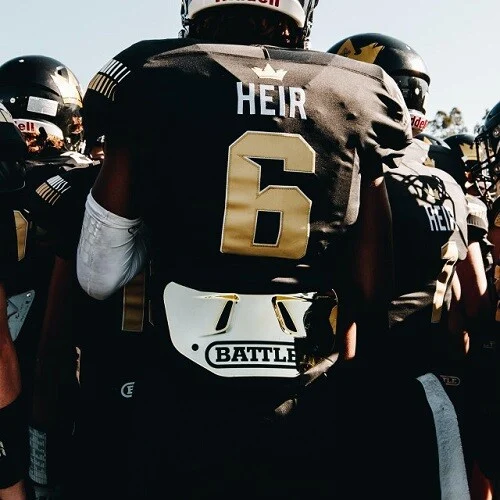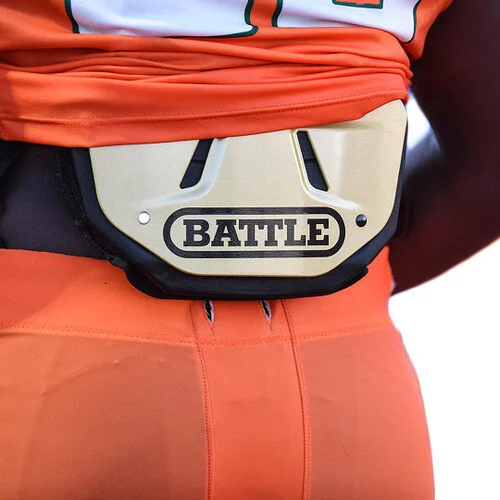Have you ever wondered if linemen wear back plates? Whether you're buying gear for yourself or your child, it's a common question. So, do linemen really wear back plates? And does every player need one? The quick answer is yes: linemen (and players in every position) can and often do wear football back plates.1 In fact, linemen might be some of the most crucial candidates for wearing back plates. Because they frequently receive hard hits, linemen can greatly benefit from the added spinal protection that a back plate offers. In the following sections, we'll delve deeper into the specifics of back plates, outline some of their advantages, and discuss important factors for linemen seeking the perfect back plate. Let's start with the fundamentals. What is a football back plate? A back plate is: Back plates function similarly to other football pads: they distribute the impact of a hit over a larger area, shielding the body from powerful tackles and falls. Helmets and football mouthguards also follow this principle. Specifically, back plates protect the lower spine—a region particularly prone to injuries.2 During a game, you might experience impacts to the back during tackles or accidental falls. However, beyond protection, back plates can enhance your football style. Whether you opt for your team's colors, decorate your back plate with intimidating stickers, or go for a bold graffiti design, your back plate can unify your entire outfit and allow you to express your individuality on the field. Back plates are usually not mandatory for linemen (or any other position), but double-check your league or school's regulations carefully. Some organizations might require them, and you wouldn't want to show up unprepared for practice. Ensuring that all your equipment is complete—like football gloves, shoulder pads, and a properly fitted football helmet—is vital for being ready for practice and games. Even if your organization doesn't require back plates, it's worth considering adding one to your kit for maximum protection.3 One of the best ways to prevent football injuries is to use equipment that: A back plate can help prevent injuries to your: Although they may not always seem critical, the bones in your back and butt (your spine, hip bones, and tailbone) are some of the most important for your mobility. They're especially crucial for football players, who must remain highly mobile, execute explosive movements during plays, and maintain enough stability and strength to excel in their roles. Why should linemen think about wearing a back plate? Let's explore some of their key benefits. Recall what we mentioned earlier about the bones in your back and butt. Protecting these areas is essential, and it's the main purpose of a back plate. What could happen if you don't wear a back plate and suffer an injury? For football players (especially linemen, who endure some of the hardest hits), safeguarding your body from injuries should be your top priority (right after winning). While injuries are always a concern in any sport, worrying about those risks won't improve your mindset on or off the field. Instead of stressing about potential injuries, take proactive steps to reduce them. With the peace of mind that comes from knowing you've taken every precaution, you can step onto the field with confidence. And, with less mental energy spent on anxiety, you can focus fully on executing the plays at hand. Moreover, there's nothing quite like strutting onto the field looking sharp. With every piece of protective gear perfectly coordinated into your game-day look, there's nothing stopping you from dominating on every play. There's no substitute for swagger, and a back plate can easily add a splash of color or a touch of personality to your outfit. Let's face it: Linemen take a lot of heavy hits. That's their job—to protect the quarterback and receivers during offensive drives and contribute to a strong defense. Linemen get the job done, and they willingly put themselves in harm's way to do it. As a result, linemen are at risk for certain types of injuries: This is precisely why a back plate is essential for linemen. As defensive players (and when they're doing their jobs effectively), linemen are at an increased risk of contact—and thus, injuries. What should you keep in mind before purchasing a back plate? Let's cover the most important aspects. Like any other protective gear, your back plate should: Back plates typically come in two size ranges: adult and youth. Even if you're a youth player, your size might necessitate an adult size. Check out our blog for more guidance on choosing the right back plate size for football. When trying on a back plate, ensure it's the correct size by: Even if it's not explicitly stated, football style matters. A well-coordinated palette, a strong match with your teammates, or a kit that reflects your personality can make or break your confidence on the field. So, keep this in mind as you shop for a back plate. As you browse different designs and color options, draw inspiration from: If you prefer monochromatic looks or like to keep things understated, there are plenty of muted back plate designs available too. Your back plate will attach to your shoulder pads via a strap. However, you'll need some essential hardware to set it up: This hardware typically comes in a back plate hardware pack, but it's sometimes included in a back plate package. Before making your purchase online or at the sporting goods store, confirm that you have everything you need to properly wear your back plate on game day. Do linemen wear back plates? Absolutely, and for good reason—they're at the forefront of the action and need all the protection they can get. Whether you're looking for your first back plate or a fresh replacement for last season's gear, check out Battle Sports: your source for football style and equipment that makes a statement. With options in every team color, designs for every taste, and hardware that withstands the toughest tackles, you can't go wrong with anything in our collection. Start building your new kit with Battle Sports. Sources: Microfiber Cooling Towel,Cooling Towel,Ice Towel,Evaporative Cooling Towel suzhou bangneng textile co.,ltd , https://www.bangnengtowel.com
What Exactly Is a Back Plate in Football?
Are Back Plates Mandatory for Linemen?

The Benefits of Wearing a Back Plate for Linemen
Improved Lower Back Protection
Increased Comfort, Style, and Confidence on the Field
Reduced Risk of Specific Injuries for Linemen

Key Considerations When Choosing a Back Plate for Linemen
Sizing
Style
Hardware
Discover Battle Sports Back Plates Today